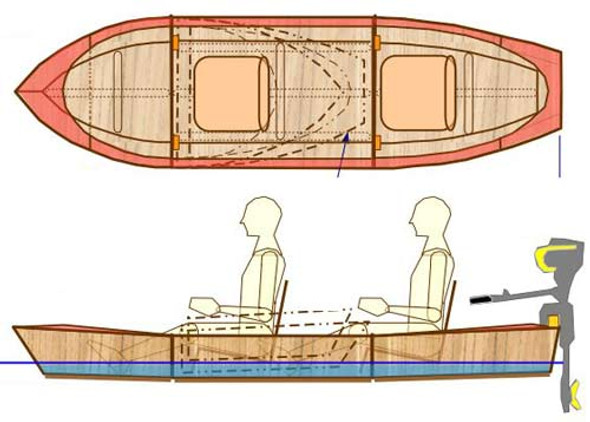Description
14ft John Duk
LOA 13ft 10", Beam 66"
OB 25Hp Max, Long Shaft
Hull weight depending on plywood thicknesses and species
used should be between 200(Okoume) to 350(Aquatek) pounds
This hull is a continuation of one of my very first designs. When I was working up the plans for a 10ft fly fishing hull for a launch customer, a version of this hull was the first model of the Hudson Springs Pram. When I showed the 10ft version of this hull to him, he wanted a "flatter bottom". I didn't really want to design a flat bottomed boat, so I made the flat part wider. After about three versions of a wider flat part, I through my hands in the air and made it all flat. I don't like "all flat" bottomed hulls, because of their tendency to remain stable until they flip with minimal warning, and no time for recovery. I always liked this style of hull and kept a model of it in my "bone pile" of hull design ideas.

I liked the narrow flat part of the bottom of the hull, as it gives a bit of stability, and keeps the hull flat when you beach it to get in or out. The "chine edges" between the flat bottom of the hull, and the two curving lower side panels also acts as a stiffener for the bottom. A pure flat bottom would need supports between the bottom and side panels to keep the hull bottom from oil canning. The narrow flat area can also be strengthened by going to a thicker plywood cross section than the rest of the hull. More strength can be added to the hull by the choice of the seating style you select. In the build and study plans I will give you some options to think about for your hull.

One more thing that I liked about not having a completely flat bottomed hull, was that the U. S. Coast Guard limits the horse power on them. By having a bit of drop/modified V to the bottom, I could use a larger OB to power it. If it was a center console hull, the max HP could go up even more, but their rules cut back on max HP when the operator is sitting in the transom area, even though this hull has a 20" transom height. The transom height as designed will require a long shaft OB, but if you have a shorter OB, you can cut the center of the transom down to fit your short shaft OB. Just make sure that you have a 20" high false transom ahead of the motor mounting area of the transom to keep water out of the hull if you come into the dock to fast and get pooped. Or from large following seas and waves. Higher is always better.

For those readers out there wondering about the name, it's a play on "Who is John Galt", as in what is a John Duk? It's not quite a Jon boat, and a bit different from a traditional duck boat too, with it's semi flat bottom, but it should be a good boat for fishing and hunting, and a lot cheaper to build/own than going out and buying an Aluminum boat. At least you can fix a wooden hull a lot easier than patching a hole in a metal one. The hull can also be sized up from the 14ft it is now to a bigger boat, if there is interest in a bigger hull. I have a 16ft version in the modeling stages now.
Have fun printing out and making the model for this hull. I added some graphics to it to get your mind thinking about all the fish and fowl you can go after.
Thanks Again
Warren Messer
Red Barn Boats










